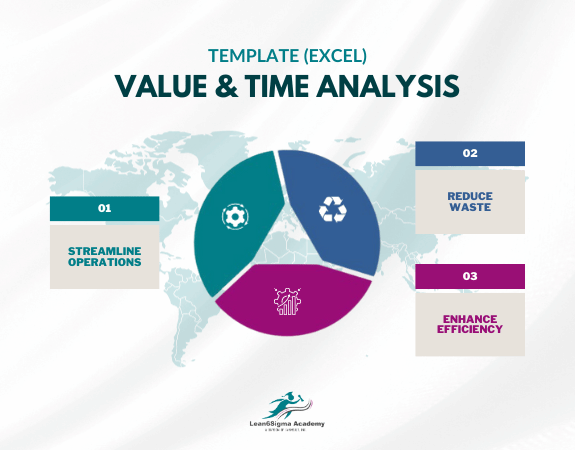Value & Time Analysis Template
Streamline Operations
Improve efficiencies in ALL Departments!
Continuously Improve any business in any sector!
Assess your Processes
Reduce Waste
Reduce costs
The template typically includes the following components:
Process Description: Begin by providing a clear description of the process, activity, or workflow you are analyzing. This should include an overview of the purpose and objectives of the process.
Participants: List the individuals or teams involved in the process. Include their roles and responsibilities within the process.
Data Collection: Describe the data collection methods and sources used to gather information about the process. This may involve interviews, surveys, observations, or data from existing systems.
Value-Added vs. Non-Value-Added Activities: Categorize the activities within the process into two main groups:
Value-Added Activities: These are activities that directly contribute to meeting customer needs or achieving the process's objectives. They are considered essential and valuable.
Non-Value-Added Activities: These are activities that do not add value to the process from the customer's perspective. They may be wasteful, unnecessary, or redundant.
Time Analysis: Analyze the time spent on each activity within the process. This can involve calculating cycle times, lead times, and wait times. Identify bottlenecks or delays that impact process efficiency.
Value-Added Ratio: Calculate the ratio of value-added time to total cycle time. This ratio provides insight into the efficiency of the process in terms of delivering value.
Waste Identification: Identify and categorize the various forms of waste within the process. Common types of waste include overproduction, waiting, defects, unnecessary transportation, excess inventory, and underutilized talent (abbreviated as "TIMWOOD").
Root Cause Analysis: Investigate the root causes of non-value-added activities and waste within the process. Determine why these activities exist and what factors contribute to them.
Recommendations: Based on your analysis, propose specific recommendations for improving the process. These recommendations should aim to reduce non-value-added activities, eliminate waste, and optimize efficiency.
Implementation Plan: Outline a plan for implementing the recommended changes or improvements. Specify the responsible parties, timelines, and resources required for implementation.
Expected Benefits: Estimate the anticipated benefits of implementing the recommended changes. This could include improvements in cycle time, cost savings, increased customer satisfaction, or other relevant metrics.
Follow-up and Monitoring: Describe how the progress and effectiveness of the changes will be monitored and measured over time. Include plans for ongoing evaluation and adjustments as needed.
The Value & Time Analysis Template is a valuable tool for organizations seeking to enhance process efficiency, reduce operational costs, and deliver greater value to customers.
By systematically assessing processes and identifying areas for improvement, teams can streamline their operations and achieve better results.
This template can be adapted to various industries and types of processes, making it a versatile tool for continuous improvement efforts.

0 Reviews
Riaan is a dynamic leader, coach, facilitator, Lean Six Sigma Master Black Belt with over 20 years of hands-on experience driving business results. Riaan is highly skilled and has worked across diverse industries internationally. With a degree in Chemical Engineering, Riaan started in the major breweries and bakeries in South Africa and was so dedicated to his work that he was often known to take his work home with him.
